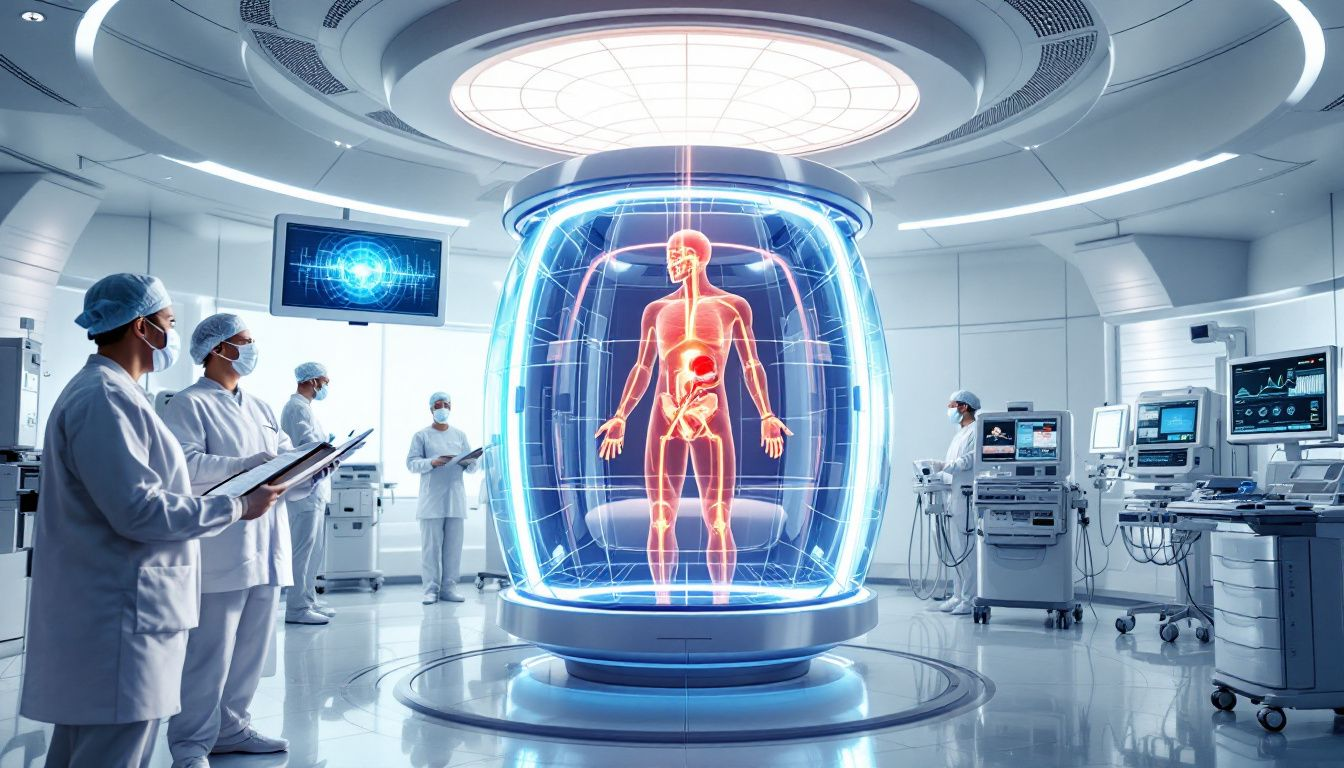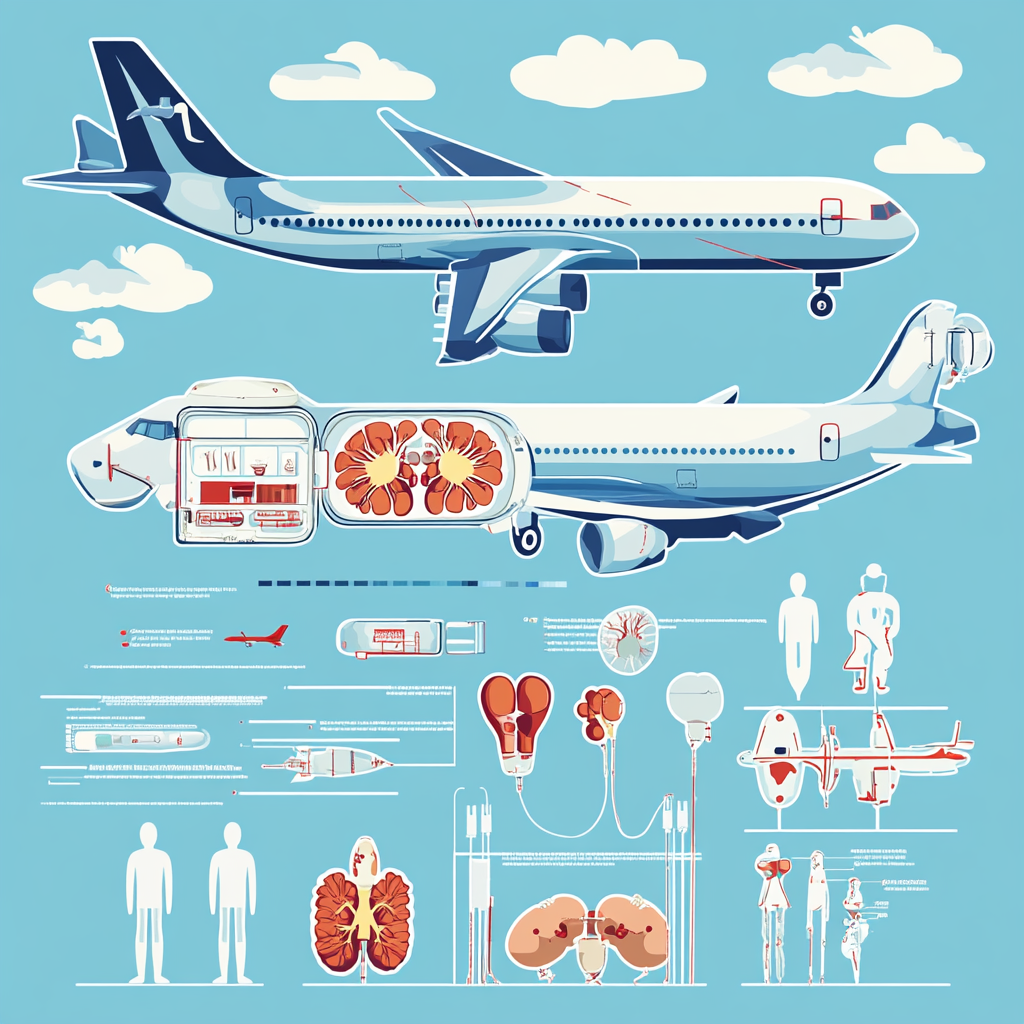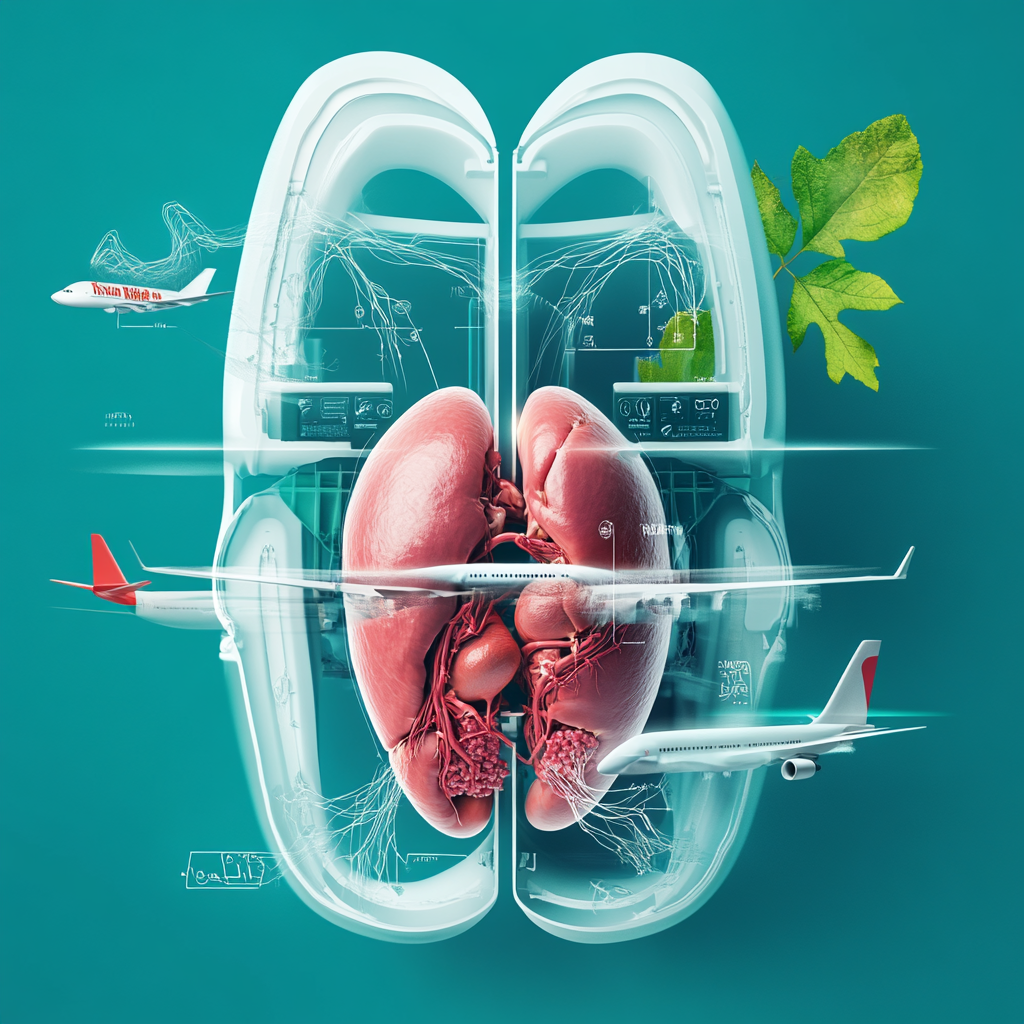Critical Lifeline: The Role of Air Transport in Kidney Transplants
Air transport is crucial in kidney transplants, ensuring donor organs reach recipients quickly and remain viable. Without efficient air transport, many kidneys would become unusable, wasting life-saving opportunities. In this article, we will examine the role of air transport in kidney transplants, highlighting how air transport enhances organ sharing, improves success rates, and bridges regional gaps in availability.
Key Takeaways
Air transport is essential for kidney transplants, improving organ sharing and saving lives through timely delivery and efficient logistics.
New airline routes and direct flights enhance the availability and viability of donor organs, addressing regional disparities and increasing successful transplant rates.
Innovations in air mobility technology, such as drones and electric aircraft, promise to improve the efficiency, reliability, and environmental sustainability of organ transport.
Importance of Air Transport in Kidney Transplants

Air transport plays a critical role in kidney transplants. New airline routes have led to a 7.3% increase in available kidneys, enhancing organ sharing and positively impacting transplant policies.
For organs procured over long distances, air transport is indispensable. The time-sensitive nature of kidney transplants necessitates quick and efficient transportation to maintain organ viability. Delays can close the window for successful transplantation, resulting in wasted opportunities and increased patient mortality.
Efficient airline transportation ensures timely arrival of donor organs and bridges regional gaps in wait times for kidney transplants. This connectivity improves the match between supply and demand, ultimately saving more lives.
Every step, from initial procurement to the journey to the transplantation center, is meticulously planned to reduce transport time and maintain organ viability. Collaboration between air transport and organ procurement organizations is vital in this life-saving process.
Airline Routes Connecting Donors and Recipients
New airline routes profoundly impact kidney sharing, leading to a 7.3% increase in kidneys transported to transplant centers. This improvement enhances the chances of efficiently matching donors and recipients, saving lives.
Efficient airline logistics are key to matching the supply and demand of donor organs, especially kidneys. Optimizing airline routes reduces travel time, making long-distance transport feasible and addressing regional disparities in organ availability.
Commercial airlines play a key role in international organ exchange, optimizing the availability of suitable organs for transplantation. This global network allows organs to be transported across borders, increasing the pool of available kidneys and improving transplant success rates globally.
Direct Flights for Reduced Travel Time
Direct flights are crucial for timely kidney sharing due to the urgency of organ transport and transplants. Shorter travel times increase the chances that the organ will remain viable for successful transplantation upon arrival.
Academics argue that direct flights are necessary for long-distance kidney sharing. Transporting organs quickly without multiple layovers is crucial for maintaining viability, reducing risks of delays and logistical complexities.
Direct flights are ideal for organ transport as they enable quick and convenient transfer. Minimizing transfers and handling significantly reduces the risk of damage or delays, ensuring the organ reaches the recipient in optimal condition.
Commercial Airlines and Organ Transport

Regular commercial flights are a key method for transporting human organs over long distances, particularly kidneys and pancreas. While airlines take utmost care, they do not assume responsibility for these precious cargoes.
Airlines pack organs in specialized containers that maintain low temperatures, crucial for preserving viability during transit. Companies like TransMedics use portable mini-laboratories to control the environment of organs during transport.
Organizations like AirMed specialize in transporting organs and procurement teams, focusing on critical and time-sensitive logistics. AirMed’s medical crew, experienced in transporting transplant patients and organs, enhance operational efficiency and service quality.
The COVID-19 pandemic reduced the number of routes and increased logistical complexity for kidney transportation. This highlighted the need for robust and adaptable transport solutions to ensure organ transplants could continue despite global disruptions.
Did you know that you can get from Manhattan to JFK in under 5 minutes without driving?
Blade offers seamless helicopter transfers from our West 30th Street Lounge in Manhattan to JFK Airport in just 5 minutes from $195 per seat.
Skip the traffic and ditch the stress with Blade's year-round airport service.

Advanced Air Mobility Solutions
Advanced air mobility (AAM), including drones and eVTOLs, can enhance the efficiency of organ transport in healthcare. The increase in organ transplants has raised costs and complicated logistics, prompting a shift towards these advanced options.
Electric drones and air taxis are being developed to address logistical challenges in the science behind organ preservation, ensuring better viability and efficiency. Companies like BETA Technologies aim to create electric air taxis for safer and more efficient transport. Autonomous drones could lower transport costs and environmental impact by eliminating the need for a pilot.
Drones have been tested for delivering organs in real-world scenarios, showing potential for intra-city transportation. Research indicates that a significant percentage of organ transport trips fall within the operational range of AAM technology, making it viable for kidney transplants.
eVTOLs can enhance payload capacity and accommodate medical personnel during transport. Electric aircraft like the ALIA air taxi are being designed to carry organs more environmentally friendly, reducing reliance on fossil fuels.
Coordinating with Organ Procurement Organizations
Collaboration between air transport services and organ procurement organizations streamlines the transportation process, positively impacting patient outcomes. This partnership ensures a rapid response once an organ becomes available, facilitating timely transportation.
Effective preplanning by air transport teams addresses the urgency of organ transport, allowing for quick decisions tailored to specific transplant needs. This significantly enhances the efficiency and reliability of kidney transplants, reducing ischemia time and improving success rates.
Working closely with organ procurement organizations, air transport services can optimize every aspect of the transport process, from initial procurement to delivery at the organ transplantation activities center.
Case Studies: Successful Air Transport for Kidney Transplants

Successful trials have shown that organs can be transported by drones, including a lung and a kidney in separate flights. These case studies highlight the potential of advanced air mobility solutions in organ transport.
One notable case involved the successful drone transport of a kidney, which was then transplanted into a patient with excellent results. This trial showcased the feasibility and efficiency of using drones for organ transport, paving the way for broader adoption of this technology.
These case studies provide valuable insights into the practical application of innovative air transport solutions, demonstrating their potential to revolutionize organ transplantation logistics and improve patient outcomes.
Challenges in Air Transport for Kidney Transplants

Approximately 5,000 individuals in the U.S. die annually while waiting for a kidney transplant, highlighting the urgency for efficient organ transport. However, many challenges persist in the air transport of kidneys.
One significant challenge is the high rate of transportation failures due to cancelled or delayed flights, accounting for 49.4% of these failures. Airlines face issues like reduced capacity and trimmed routes, complicating the logistics of organ transport.
Logistical complexities require air services to ensure comfort and safety for both the organ and procurement teams, including provisions like portable oxygen concentrators. Improving airline transportation infrastructure is essential for policymakers to enhance organ-sharing policies and ensure timely transplants.
A study revealed that improved airline connectivity can lower the discard rate of kidneys, indicating more efficient use of available organs. Addressing these challenges is crucial for improving kidney transplant outcomes and saving more lives.
Did you know that you can get from Manhattan to JFK in under 5 minutes without driving?
Blade offers seamless helicopter transfers from our West 30th Street Lounge in Manhattan to JFK Airport in just 5 minutes from $195 per seat.
Skip the traffic and ditch the stress with Blade's year-round airport service.

Innovations in Air Transport Technology
Technological innovations are transforming air transport for organ transplantation and transplant surgery. Established best practices include crew training and operational protocols to ensure efficient and safe transport.
The choice of aircraft for organ transport depends on factors like time sensitivity, operational needs, and distance. Current battery technologies limit the range of AAM aircraft, but advancements could allow for transport over distances exceeding 150 km.
Innovations in transport containers extend the viability of organs during transit, potentially reducing emissions by optimizing logistics. These advancements promise more efficient and environmentally friendly organ transport.
Rethinking organ transport efficiency is essential for the future of solid organ transplantation. Continued innovation and adoption of new technologies are key to overcoming challenges and improving outcomes.
Environmental Impact of Air Transport in Organ Transplantation

Transporting human organs by air contributes to greenhouse gas emissions, necessitating sustainable alternatives. As demand for organ transplants increases, so does the need for environmentally friendly transport solutions.
The development of electric drones and air taxis is a significant step towards reducing the environmental impact of organ transport. These advanced air mobility solutions offer a greener alternative to traditional air transport, balancing urgent medical needs with environmental concerns.
Finding sustainable solutions for organ transport is crucial for the future of healthcare and the planet. Investing in innovative technologies and practices ensures life-saving transplants continue while minimizing the environmental footprint.
Bottom Line: Critical Lifeline: The Role of Air Transport in Kidney Transplants
In summary, air transport plays a critical role in kidney transplants, from connecting donors and recipients to ensuring the timely arrival of organs. The collaboration between air transport services and organ procurement organizations, along with advancements in technology, has the potential to revolutionize organ transportation.
As we look to the future, continued innovation and investment in sustainable transport solutions will be essential. By addressing the challenges and embracing new technologies, we can improve the outcomes of kidney transplants and save more lives.
FAQs about Critical Lifeline: The Role of Air Transport in Kidney Transplants
Why is air transport crucial for kidney transplants?
Air transport is crucial for kidney transplants because it facilitates the rapid and efficient movement of organs, ensuring they remain viable for transplantation within the critical time window. This capability significantly increases the chances of successful outcomes for patients in need.
How do new airline routes impact kidney sharing?
New airline routes significantly improve kidney sharing by expanding donor organ availability and minimizing travel time, ultimately facilitating timely transplants for those in need.
What role do commercial airlines play in organ transport?
Commercial airlines play a crucial role in organ transport by partnering with organizations like AirMed, using specialized containers to ensure timely and safe delivery of human organs. This collaboration is vital for successful transplants and saving lives.
What are some challenges in air transport for kidney transplants?
Timely delivery of organs for kidney transplants faces significant challenges such as flight cancellations, logistical complexities, and reduced airline routes. These factors can critically hinder the effectiveness of transplant operations.
How can advanced air mobility solutions benefit organ transport?
Advanced air mobility solutions can significantly enhance organ transport by providing faster, more efficient, and cost-effective means to deliver these critical resources, ensuring timely access to life-saving transplants. This innovation not only addresses logistical challenges but also minimizes the environmental impact of transportation.
Disclaimer:
Please be aware that the content on this page has been generated by using artificial intelligence language models and may contain errors, inconsistencies, or outdated information. It is provided as-is without any warranties or guarantees of accuracy. We strongly recommend using this content as a starting point for further research. We disclaim any liability for damages or losses resulting from the use or reliance on this content.